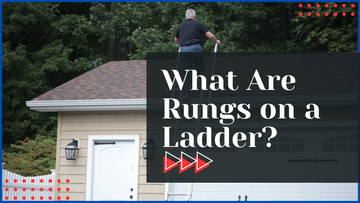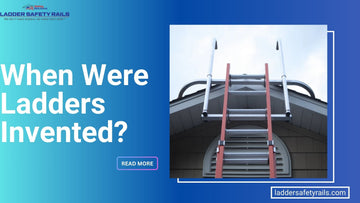
If you’ve ever tackled a home project, changed a ceiling light, or painted a wall, chances are you've used a ladder—and stood on its most essential part: the rungs. But what are rungs on a ladder, really? They're more than just footrests.
These sturdy horizontal bars are the backbone of safe climbing, supporting your weight and providing stability as you ascend. Let’s dive into the nitty-gritty of ladder anatomy and uncover why rungs are the unsung heroes of every successful DIY mission.
Understanding Ladder Anatomy: The Basics
To appreciate the importance of ladder rungs, it helps to understand the full picture of a ladder’s anatomy. Every ladder, regardless of type or size, includes a few standard ladder components that work together to support your body and help you reach new heights.
At its core, a ladder has rails, which are the vertical side pieces that run the length of the ladder. Between these rails are the rungs—the horizontal pieces you step on. Then there are spreaders, which are found in step ladder components and help the ladder stand securely when opened.
At the base, feet or shoes prevent slipping by gripping the surface. And on many ladders, especially step ladders, the top cap provides a handy space to set tools or paint cans.
What Are the Rungs on a Ladder?
What are the rungs on a ladder? Rungs are horizontal bars or ladder bars that run between the two vertical side rails. They’re where your feet go when you're climbing up or down.
These bars are built to support your full body weight and must offer a firm, non-slip surface, especially when you're balancing tools or working high above ground.
Depending on the ladder type, rungs can differ in shape and material. Some are round and smooth, common in industrial settings. Others are D-shaped—a design that offers a flatter surface on top for added foot comfort.
You’ll also find flat rungs on step ladders, which prioritize comfort and stability for standing in place during jobs like painting or wiring.
Here’s a quick overview of common rung types:
Types of Rungs
|
Shape |
Best For |
Comfort Level |
|
Round |
Industrial and utility work |
Moderate |
|
D-shaped |
Parts of an extension ladder |
High |
|
Flat |
Parts of a step ladder |
Very high |
Rungs vs. Steps: Is There a Difference?

You might’ve heard people use the words "rungs" and "steps" interchangeably when talking about ladders. But here’s the deal: while they serve similar purposes, there is a subtle difference.
On a straight or extension ladder, the horizontal elements are usually called rungs. On step ladders, which are more like a folding staircase, these are more accurately called steps—though in casual usage, both terms get tossed around a lot.
In general, all ladder components work in harmony, but it's the rungs or steps that do the heavy lifting—literally. Understanding these distinctions helps you not only shop smarter but also use your tools more safely. Whether it’s a step ladder component or a part of an extension ladder, knowing what to call it can make a difference when troubleshooting, replacing parts, or just explaining your needs at the hardware store.
Key Parts of a Ladder: Beyond the Rungs
Ladders aren’t just rungs and rails. A well-designed ladder is a blend of several components of a step ladder or extension ladder, depending on the model, each playing a critical role in your safety and convenience.
Let’s break down some of the essential parts of a ladder beyond the rungs:
- Side Rails: These vertical elements run along the sides and are the frame holding the rungs together. Without strong side rails, your ladder wouldn't stand tall.
- Feet or Shoes: These are often rubber-coated and provide a stable grip on the ground. They're the first line of defense against slipping.
- Spreaders: Only found in step ladder components, these hinged metal arms keep the ladder from collapsing inward.
- Locks and Brackets: In parts of an extension ladder, these keep the moving sections locked securely in place.
- Top Cap: That flat plastic or metal piece at the top of a step ladder isn’t just decorative. It often has slots for holding tools or screws, which is a big help in mid-project

Common Ladder Types and Their Rungs
The design of rungs changes based on ladder type and knowing this helps you choose the right ladder for your task. Not every ladder is created equal—some are built for quick indoor chores, while others are meant to scale rooftops and scaffolding.
Here are a few popular types:
- Step Ladder: This classic ladder stands freely and includes wide, flat steps (technically still rungs) for great comfort. It’s ideal for household jobs like hanging curtains or reaching a high shelf.
- Extension Ladder: This one leans against a wall and extends to great heights. Its rungs are often narrower and D-shaped, built for grip and efficiency.
- Multi-Position Ladder: Kind of the Swiss Army knife of ladders. It transforms into various configurations, each with its own rung of a ladder system designed for that shape.
No matter the type, knowing the parts of a ladder, including the rungs, gives you the confidence to work safely and smartly.
Materials Used in Ladder Rungs

Not all rungs are made the same. The material used in your ladder rungs can drastically affect its weight, durability, and best use scenario. Whether you're working indoors, outdoors, or around electricity, choosing the right material for your ladder is key.
Let’s look at the most common options:
- Aluminum: Lightweight and resistant to rust; aluminum rungs are common in home-use ladders. But they're conductive, so they're a no-go near electricity.
- Fiberglass: This is the safest bet for electricians. Non-conductive and super strong, fiberglass rungs are heavy but built for serious work.
- Wood: While less common today, wooden ladders still exist. They're classic, but they can warp or rot over time if not properly cared for.
Safety and Rung Spacing:
Ever notice how rungs are spaced evenly apart? That’s not a happy accident. Most ladders space their rungs of the ladder about 12 inches apart, which offers a natural stride for climbing while ensuring balance and support.
Safety features in ladder bars have evolved over the years:
-
Non-slip coatings or rubber covers improve grip.
-
Grooved surfaces help reduce foot slippage.
-
Consistent spacing keeps your body posture natural as you climb.
Proper rung spacing isn’t just about comfort—it’s about reducing fatigue and minimizing the risk of falls. So yeah, those boring old parts of ladder like rungs? They’re safety engineering at its finest.

Ladder Rung Maintenance: What to Watch For:
Like any tool, ladders need upkeep—especially their rungs. Over time, with enough use and exposure to weather, rungs of the ladder can wear down, bend, or even become loose. And trust us—you don’t want to find that out while standing 12 feet above the ground.
Here’s what to inspect regularly:
-
Look for cracks or splits, especially in wood or fiberglass.
-
Check for rust or corrosion on metal ladder bars.
-
Ensure rungs aren't bent—this can be a sign of structural weakness.
A small issue with a rung can become a big problem fast. Regular checks ensure your ladder structure stays safe and secure for every climb.
Conclusion:
Rungs are the horizontal steps on a ladder that provide support and footing as you climb. Understanding their design, spacing, and function is essential for safe and effective ladder use. Whether you're tackling a home project or working on a job site, knowing how to use ladder rungs properly can help prevent slips and injuries.
At Ladder Safety Rails, our ladder stabilizers offer extra breakthrough design and peace of mind which are the perfect addition for any task that takes you off the ground.
Visit us and shop now for smarter and safer climbing!
FAQs:
-
How to stabilize a ladder on a metal roof?
Use a ladder stabilizer and secure the base with non-slip rubber feet or even sandbags. The ladder should be set on flat ground, with the rungs level and the top secured with a roof hook or bracket to prevent sliding.
-
Can I use ladder stabilizer on shingle roof?
Yes, you can. Make sure the stabilizer has padded contact points to protect the shingles. Place it gently and ensure the ladder's components are aligned for a safe climb.
-
How stabilize ladder on sloped roof?
Use a stabilizer at the top and a ladder leveler or support block at the base. Make sure your ladder bars are aligned parallel to your body to maintain proper balance.
-
Should I use ladder stabilizer for getting onto roof?
Absolutely. A stabilizer ensures the top of your ladder stays secure, especially when you're stepping off the final rung of a ladder onto an elevated surface.
-
Should ladder stabilizer rest on roof?
It depends. Some stabilizers are designed to rest on the roof, while others are made to brace against walls or gutters. Always follow the manufacturer's guidelines and make sure your ladder structure is stable before climbing.
Read More Blogs:






